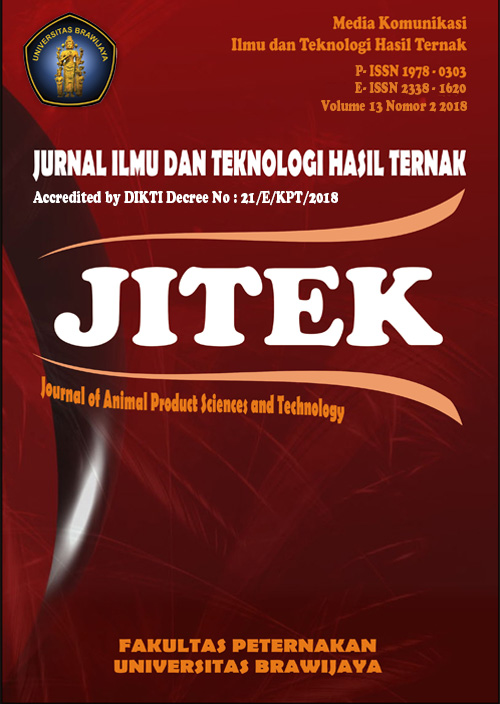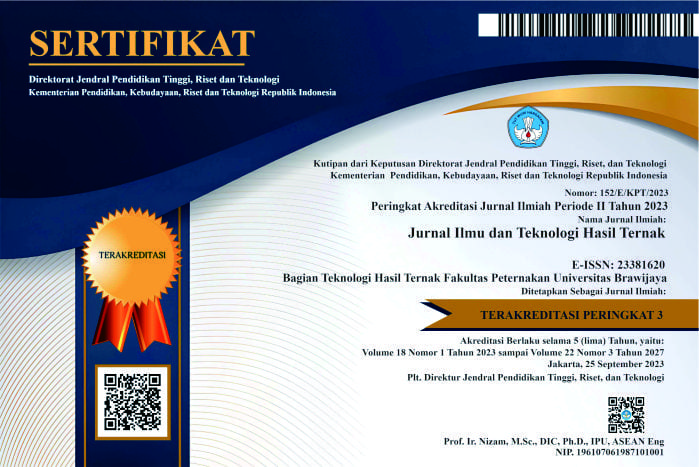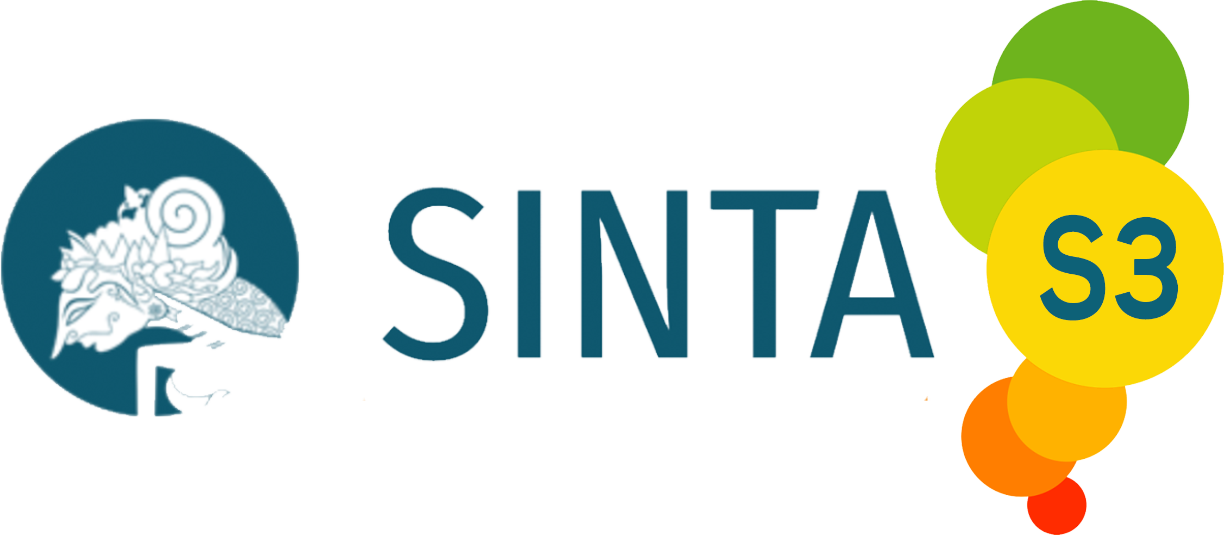Perbandingan Sifat Antioksidan Propolis pada Dua Jenis Lebah (Apis mellifera dan Trigona sp.) di Mojokerto dan Batu, Jawa Timur, Indonesia
DOI:
https://doi.org/10.21776/ub.jitek.2018.013.02.5Keywords:
Aktivitas antioksidan IC50, flavonoid, fenolik, lebah maduAbstract
Tujuan penelitian ini adalah untuk membandingkan aktivitas antioksidan, kadar total fenolik dan kadar total flavonoid propolis dari dua jenis lebah dan lokasi yang berbeda. Materi yang digunakan pada penelitian ini adalah propolis yang dihasilkan dari Apis mellifera dan Trigona sp. yang digembalakan di dua lokasi yang berbeda yaitu Batu dan Mojokerto. Metode yang digunakan adalah analisis deskriptif. Aktivitas antioksidan tertinggi dan terendah ditunjukkan oleh propolis Trigona sp. asal Mojokerto (987.24 µg/g) dan propolis Trigona sp. asal Batu (166.25 µg/g). Kadar total flavonoid tertinggi dan terendah ditunjukkan oleh propolis Apis mellifera asal Mojokerto (1.990 mg/g) dan propolis Trigona sp. asal Mojokerto (1.000 mg/g). Kadar total fenolik tertinggi dan terendah ditunjukkan oleh propolis Apis mellifera asal Mojokerto (21.980 mg/g) dan propolis Trigona sp asal Mojokerto (9.603 mg/g). Propolis Apis mellifera asal Mojokerto memiliki kandungan total flavonoid dan fenoil tertinggi dan propolis Trigona sp. asal Mojokerto memiliki nilai aktivitas antioksidan, total flavonoid dan total fenolik terendah.
References
Andrade, J. K. S., Denadai, M., de Oliveira, C. S., Nunes, M. L., & Narain, N. (2017). Evaluation of bioactive compounds potential & antioxidant activity of brown, green & red propolis from Brazilian northeast region. Food Research International, 101(1), 129–138. https://doi.org/10.1016/j.foodres.2017.08.066
Arel, A., Dira, & Setiawati, A. (2016). Isolasi senyawa utama kulit batang tumbuhan pinus dari ekstrak etil asetat. Jurnal Ilmiah Kesehatan, 12(2), 60–66.
Arivianti, S., & Parnanto, N. H. R. (2013). Kapasitas antioksidan buah salak (salacca edulis reinw) kultivar pondoh, nglumut & bali serta korelasinya dengan kadar fenolik total & vitamin C. Agritech, 33(3), 324–333. https://doi.org/10.22146/AGRITECH.9555
Chan, G. C.-F., Cheung, K.-W., & Sze, D. M.-Y. (2013). The immunomodulatory & anticancer properties of propolis. Clinical Reviews in Allergy & Immunology, 44(3), 262–273. https://doi.org/10.1007/s12016-012-8322-2
Hariyanto, R. A. B. (2017). Penentuan Kandungan Fenolik, Flavonoid & Aktivitas Antioksidan Ekstrak Propolis Trigona Sp. Surabaya: ultas Matematika & Ilmu Pengetahuan Alam Institut Teknologi Sepuluh Nopember.
Hasan, A. E. Z., Mangunwidjaja, D., Sunarti, T. C., Suparno, O., & Setiyono, A. (2014). Investigating the antioxidant & anticytotoxic activities of propolis collected from five regions of Indonesia & their abilities to induce apoptosis. Emirates Journal of Food & Agriculture, 26(5), 390–398. https://doi.org/10.9755/ejfa.v26i5.16549
Hasan, A. E. Z., Mangunwidjaja, D., Sunarti, T. C., Suparno, O., & Setyo, A. (2013). Optimasi ekstraksi propolis menggunakan cara maserasi dengan pelarut etanol 70% & pemanasan gelombang mikro serta karakterisasinya sebagai bahan antikanker payudara. Journal of Agroindustrial Technology, 23(1), 13–21.
Indrawati, N., & Razimin. (2013). Bawang Dayak SI Umbi Ajaib Penakluk Aneka Penyakit. Jakarta Selatan: Agromedia Pustaka.
Jaya, F. (2006). Produk-Produk Lebah Madu & Hasil Olahannya. Malang: Universitas Brawijaya Press.
Jug, M., KonÄić, M. Z., & Kosalec, I. (2014). Modulation of antioxidant, chelating & antimicrobial activity of poplar chemo-type propolis by extraction procures. LWT - Food Science & Technology, 57(2), 530–537. https://doi.org/10.1016/J.LWT.2014.02.006
Junita, D., Setiawan, B., Anwar, F., & Muhandri, T. (2017). Komponen gizi, aktivitas antioksidan & karakteristik sensori bubuk fungsional labu kuning (Cucurbita moschata) & tempe. Jurnal Gizi & Pangan, 12(2), 109–116. https://doi.org/10.25182/JGP.2017.12.2.109-116
Juspawiza, M. (2013). Potensi Nanopropolis Lebah Madu Trigona Spp & Lebah Madu Apis Mellifera Sebagai Antioksidan. (Skripsi) Bogor : Fakultas Matematika & Ilmu Pengetahuan Alam Institut Pertanian.
Khalil, M. I., Moniruzzaman, M., Boukraâ, L., Benhanifia, M., Islam, M. A., Islam, M. N., Gan, S. H. (2012). Physicochemical & antioxidant properties of algerian honey. Molecules, 17(9), 11199–11215. https://doi.org/10.3390/molecules170911199
Laskar, R. A., Sk, I., Roy, N., & Begum, N. A. (2010). Antioxidant activity of Indian propolis & its chemical constituents. Food Chemistry, 122(1), 233–237. https://doi.org/10.1016/J.FOODCHEM.2010.02.068
Lukmandaru, G., Vembrianto, K., & Gazidy, A. A. (2014). Aktivitas antioksidan ekstrak metanol kayu mangifera indica l., mangifera foetida lour, & mangifera odorata griff. Jurnal Ilmu Kehutanan, 6(1), 18–29. https://doi.org/10.22146/JIK.3306
Marghitas, L. A., Dezmirean, D. S., Margaona, R., & Mihai, C. M. (2011). Physico-chemical characterization & antioxidant activity of transylvanian propolis. Economics, Management, & Financial Markets, 6(1), 1228–1234.
Miguel, M. G., Nunes, S., Dandlen, S. A., Cavaco, A. M., & Antunes, M. D. (2010). Phenols & antioxidant activity of hydro-alcoholic extracts of propolis from Algarve, South of Portugal. Food & Chemical Toxicology, 48(12), 3418–3423. https://doi.org/10.1016/j.fct.2010.09.014
Neldawati, N. (2013). Analisis Nilai Absorbansi dalam Penentuan kadar flavonoid untuk berbagai jenis daun tanaman obat. PIllar Of Physics, 2(1), 76–83. https://doi.org/10.24036/756171074
Osés, S. M., Pascual-Maté, A., Fernández-Muiño, M. A., López-DÃaz, T. M., & Sancho, M. T. (2016). Bioactive properties of honey with propolis. Food Chemistry, 196, 1215–1223. https://doi.org/10.1016/J.FOODCHEM.2015.10.050
Parwata, I. M. O. A., Ratnayani, K., & Listya, A. (2010). Aktivitas antiradikal bebas serta beta karoten pada madu randu (ceiba petandra) & madu kelengkeng (nephelium longata l.). J. Kimia, 4(1), 54–62.
Rismayanti. (2014). Ecology Service Tumbuhan Herba Untuk Lebah Trigona sp. (Skripsi) Bogor: Fakultas Matematika & Ilmu Pengetahuan Alam Institut Pertanian.
Sabir, A. (2005). Respons inflamasi pada pulpa gigi tikus setelah aplikasi ekstrak etanol propolis (EEP). Dental Journal (Majalah Kedokteran Gigi), 38(2), 77–83. https://doi.org/10.20473/j.djmkg.v38.i2.p77-83
Saric, G., Markovic, K., Major, N., Karpan, M., Ursulin-Trstenjak, N., Hruskar, M., & Vahcic, N. (2012). Changes of antioxidant activity & phenolic content in acacia & multifloral honey during storage. Food Technol. Biotechnol, 50(4), 437.
Segueni, N., Zellagui, A., Moussaoui, F., Lahouel, M., & Rhouati, S. (2016). Flavonoids from Algerian propolis. Arabian Journal of Chemistry, 9(1), 425–428. https://doi.org/10.1016/J.ARABJC.2011.05.013
Sharma, G. N., Dubey, S. K., Sati, N., & Sanadya, J. (2011). Phytochemical screening & estimation of total phenolic content in aegle marmelos seeds. International. International. Journal of Pharmaceutical & Clinical Research, 3(2), 27–29.
Simone-Finstrom, M., & Spivak, M. (2010). Propolis & bee health: the natural history & significance of resin use by honey bees. Apidologie, 41(3), 295–311. https://doi.org/10.1051/apido/2010016
Suranto, A. (2010). Dahsyatnya Propolis untuk Menggempur Penyakit. Jakarta: Agromedia Pustaka.
Trusheva, B., Popova, M., Bankova, V., Simova, S., Marcucci, M. C., Miorin, P. L., Tsvetkova, I. (2006). Bioactive constituents of brazilian red propolis. Evidence-Based Complementary & Alternative Medicine : ECAM, 3(2), 249–254. https://doi.org/10.1093/ecam/nel006
Wang, X., Sankarapandian, K., Cheng, Y., Woo, S. O., Kwon, H. W., Perumalsamy, H., & Ahn, Y.-J. (2016). Relationship between total phenolic contents & biological properties of propolis from 20 different regions in South Korea. BMC Complementary & Alternative Medicine, 16(1), 1–12. https://doi.org/10.1186/s12906-016-1043-y
Widyasari, R. (2006). Pengujian Asam Semut & Cuka Kayu dalam Pengendalian Tungau (Varroa destructor) Pada Lebah Madu (Apis mellifera). (Skripsi) Bogor: Fakultas Kehutanan Institut Pertanian.
Winarti, S. (2010). Makanan Fungsional. Yogyakarta: Graha Ilmu.
Downloads
Published
Issue
Section
License
Copyright (c) 2018 Djalal Rosyidi, Lilik Eka Radiati, Sri Minarti, Mustakim Mustakim, Agus Susilo, Firman Jaya, Abdul Azis

This work is licensed under a Creative Commons Attribution 4.0 International License.
Authors who publish with this journal agree to the following terms:
- Authors retain copyright and grant the journal right of first publication with the work simultaneously licensed under a Creative Commons Attribution License that allows others to share the work with an acknowledgement of the work's authorship and initial publication in this journal.
- Authors are able to enter into separate, additional contractual arrangements for the non-exclusive distribution of the journal's published version of the work (e.g., post it to an institutional repository or publish it in a book), with an acknowledgement of its initial publication in this journal.
- Authors are permitted and encouraged to post their work online (e.g., in institutional repositories or on their website) prior to and during the submission process, as it can lead to productive exchanges, as well as earlier and greater citation of published work (See The Effect of Open Access).















